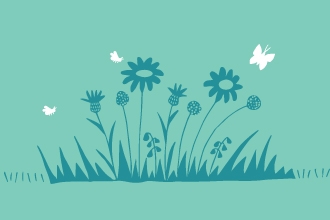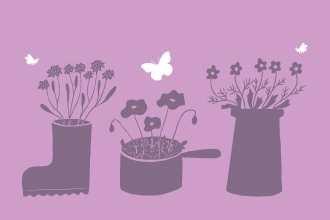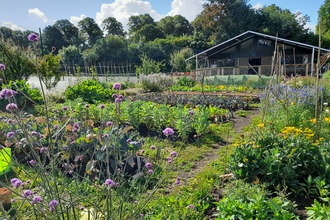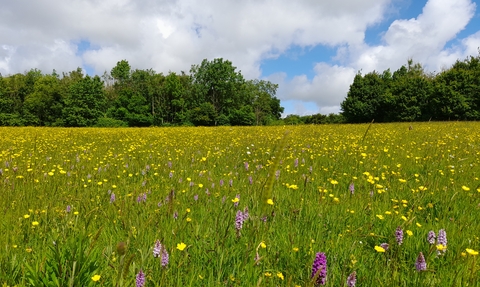
(C) Caitlin Coombs
Team Wilder Community Wildflower Meadows
Wildflower meadows for local people and wildlife
Wildflower meadows are a valuable and sparse habitat in the UK. A single meadow can host over 100 species of wildflowers, which in turn provides food sources and nectar for insects, providing essential food for mammals and birds. They are characterised by a diverse mixture of tall grasses and colourful wildflowers, such as white oxeye daisy, purple knapweed and yellow meadow vetchling, and hit their peak in the late spring and early summer when they buzz with insects attracted by the abundant nectar sources they provide. Wildflower meadows are beautiful!
How to create a community wildflower meadow
Winterbourne Environmental group shared their first-hand experience about forming a group and creating their wildflower meadow. Read their full story here.
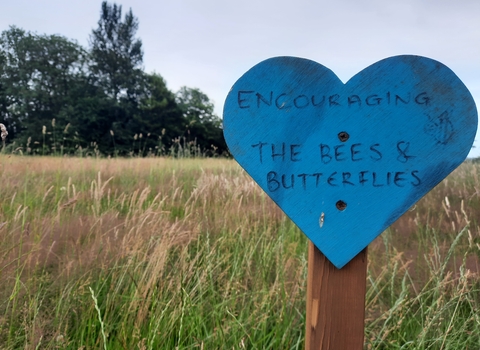
Winterbourne and Frome Valley Environmental Group
How to Start a Wildflower Meadow in the Community
One of the objectives created by WEG was to start a wildflower meadow on a local site - Small Common at Whiteshill.
The first task was to find out who owned the land.
RESOURCE: Find out who owns the land
The local Parish Council were the owners. Next task: how do you speak to the local Parish Council?
WEG found out when the next parish Council was taking place and asked to present their plan for the wildflower meadow at it. Daunting as this sounds, it is an opportunity to speak directly to the people that make decisions on such matters.
ADVICE from Laura about messaging the council: Keep going. It took 6 months and 20 emails!
How West Bristol Climate Action planted a wildflower meadow
WBCA How to make a wildflower meadow (https://www.youtube.com/watch?v=k1ay1CRNQlI)
West Bristol Climate Action
West Bristol Climate Action (WBCA) are a dedicated group of people and have shared their knowledge and key learnings on this brilliant video. It shows how they involved the community, valuable advice about creating a wildflower meadow and the different techniques applied to see what works best for their site. WBCA brought the community together to plan, create and maintain the wildflower meadow.
See their advice about how to propose a meadow on council land and learn more about the different techniques used to plant the meadows, how they encourage local residents to continue the habitat in their own gardens and educate everyone with wildflower spotter sheets.
West Bristol Climate Action Clifton Hill Meadow.
What to plant in a wildflower meadow
We’d love it if you copied Clifton Hill and helped out lots of bees and butterflies with all that pollen. We'd recommend buying your seeds from the Avon Wildlife Trust's excellent Grow Wilder project, as we did. They created a tailored mix for us, consisting of...
agrimony, betony, bladder campion, common knapweed, corky-fruited water-dropwort, corn chamomile, corn marigold, corn poppy, corncockle, cornflower, crosswort, devil's bit scabious, dropwort, field scabious, greater knapweed, hedge bedstraw, kidney vetch, lady's bedstraw, meadow buttercup, meadowsweet, musk mallow, oxeye daisy, pepper saxifrage, ribwort plantain, rough hawkbit, salad burnet, selfheal, small scabious, wild marjoram, and yellow rattle.West Bristol Climate Action
Communication and involvement with local residents - good signage ideas
There are some impressive signs shown above to help spread the good word about what is happening in regards to creating wildflower meadows. It's important to let local residents know and understand what you're creating and how they can get involved and have their say. Some people may think it looks 'messy' and not everyone will be on board. That's ok. Wildflower meadows are not obvious out of season or while they're being established, it can take time. Signs on site need to be designed, involve a cost to be created and require maintenance. Other ways to communicate what's happening is in person, at community events, community group social media, email and/or via a website. Local schools might also be keen to get involved.
Wildflower meadow maintenance

Manor Woods Valley Group
Meadows were traditionally managed with a late summer hay cut, followed by grazing in autumn, before being allowed to grow tall and lush in the spring and summer. This management allowed plants such as orchids and primroses to persist along with more competitive species.
There are many different wildflower meadows today. Community wildflower meadows have to be maintained to allow wildflowers to survive and not get overtaken by grass and other evasive species. Once planted in, the wildflower species will change over the years as the plants adapt and compete to survive. Each meadow will have different needs, but there are some basic principles which can be applied.
ADVICE:
- Wildflowers need poor soil (not nutrient rich)
- Full sun is best – note nearby trees or buildings causing shade as grass will grow here
- Yellow rattle reduces grass growth
- Meadows change from year-to-year - observe/survey what grows and which evasive species need to be managed
- When cutting the meadow, it is best to cut in autumn/early winter when dry. There are different methods to cut the meadow including grazing, scything by hand and using machinery of various sizes.
Plantlife expertly explain wildflower meadow management in more detail.

(C) Sam Martlew
Grow Wilder are able to offer specific advice about what to plant and how to plant it. Their wildflower nursery has provided plant plugs, seed and advice to many community groups and projects.
Consider a long term view when planning a community meadow
When planning to create a meadow a long term view is essential. especially when applying for funding to add pollinator friendly plants to an area. Here are a few considerations:
- Involve the local community for greater ownership of the meadow. Many people have different talents and can all contribute to the future success of a meadow - not just the physical planting and maintenance.
- Create a group, if one doesn't already exist.
- Look for local training opportunities. This can be through Team Wilder, the local council, organisations such as the Bristol Natural History Consortium, BART, Bugslife, RSPB, RHS, there are many local charities that offer free, paid for and subsidised training.
- Connect with other groups, areas and local gardens to share knowledge, resources and create a corridor.
- Apply for funding to secure maintenance of the site or raise money through fundraising events.
- Create a long term management plan.
Team Wilder will help share knowledge, advice through resources and events. Add your group or project to the Team Wilder Community map to receive updates about this. Be part of something bigger with Team Wilder.
Linking to local areas
What is the surrounding area to the meadow? If another open green space is nearby, what lands is between them - gardens and community spaces are perfect to link habitat spaces to create a green corridor. This is essential to the survival of many wildlife species.
Upload your actions for nature on the Team Wilder actions map and spot potential corridors or hedgehog highways. You can add small and large actions for nature at home, in the community and beyond.
Create a wildflower meadow at home, in your local community as shown above, at your school or wherever you can find space. Compliment the wildflower species already growing and you can even plant wildflowers to help specific species, such as growing kidney vetch for the small blue butterfly.
B-Lines ran by Buglife is a national project that connects green spaces and creates permanent wildflower-rich habitats to link existing wildlife areas together. Learn more about B-Lines and Avon Wildlife Trust.
Blooming Whiteway are very active in developing their local area to increase biodiversity for the benefit of wildlife and people. As well as holding community events and front garden competitions, park edges have been left to grow wild and proved to hold many natives plants hidden in the soil seedbank. A community wildflower meadow has also been created, which also educated local residents about the importance of this habitat.
Manor Woods Valley wildflower meadows

Manor Woods Valley Group
The wildflower meadows in Manor Woods Valley (BS3 5XX) are community managed and supports bee and common-spotted orchids, vetches, ox-eye daisies, pale flax and the corky-fruited water dropwort.
There are four meadows on site. A hay crop is taken off the large wildflower meadow every year. This has the effect of preventing the establishment of scrub and removing nutrients, which encourages wildflowers and discourages grass. The other smaller meadows are managed by hand by volunteers. Each meadow supports different wildflowers, in turn supporting different wildlife species including grasshoppers, butterflies, day-flying moths, slow worms, rabbits and many more.
Read more about and visit Manor Woods Valley
Resources

(C) Hannah Bunn
Be part of Team Wilder
All actions for nature collectively add up and creates life for people and wildlife.
Share your actions for nature, like Tom by sharing and tagging @avonwt on social media and
Log your actions for nature on the map
























